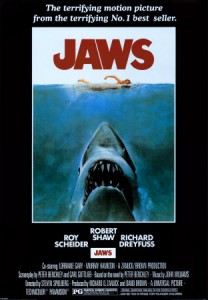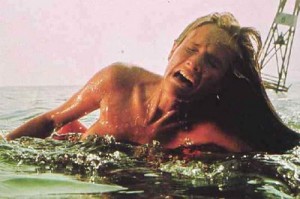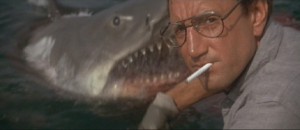 This is the movie that changed the way I thought about films and the craft of filmmaking. I’d always loved movies, but I’d never seriously considered that some movies could be better than others. Before Jaws I was completely content with Disney comedies about sentient Volkswagens and field-goal-kicking mules.
This is the movie that changed the way I thought about films and the craft of filmmaking. I’d always loved movies, but I’d never seriously considered that some movies could be better than others. Before Jaws I was completely content with Disney comedies about sentient Volkswagens and field-goal-kicking mules.
Jaws opened on June 20, 1975. It was the first PG-rated film my parents wouldn’t allow me to see, so when school started back that fall, I was pretty much the only fourth grader who hadn’t seen it.
My parents and I finally caught a showing a couple of years later when I was 12, which turned out to be the perfect age. I was literally shaking throughout the entire movie, I was so scared; I’d seen movies before in which animals attacked people, but I’d never experienced anything like this before. Sitting in the back seat during the car ride home from Jaws was the first time I had aspirations of becoming a filmmaker — I wanted to make other people experience what I’d just experienced.
To this day, I think it’s the scariest movie ever made. It also happens to be my favorite movie of all time.
I distinctly remember being surprised by how much you didn’t see during the first half of the movie. I’d heard so much about Jaws on the fourth-grade playground, including meaningful observations like “It’s cool! A guy gets his leg bitten off!” During the first shark attack you don’t see the shark, but it’s just so brutal the way actress-stuntwoman Susan Backlinie flails her arms about and jerks her body back and forth in the water. It’s scarier that you don’t see anything because that’s exactly how it would be if you were the victim — you’d feel yourself being ripped apart from below without being able to tell what was doing it.
 Years later I discovered that one major reason why so little of the shark was shown in the first few reels was because “Bruce,” the film’s custom-built mechanical shark, wasn’t working properly — but that’s another story.
Years later I discovered that one major reason why so little of the shark was shown in the first few reels was because “Bruce,” the film’s custom-built mechanical shark, wasn’t working properly — but that’s another story.
This was director Steven Spielberg’s second feature film, after The Sugarland Express (1974). I didn’t know it at the time, but he’d already scared the crap out of me with a little 1971 TV movie called Duel, starring Dennis Weaver as a motorist who’s menaced on a two-lane highway by an unseen truck driver.
One important aspect of Jaws that adds to the overall tension is that Spielberg chose to shoot the film’s swimming sequences primarily from water level, the same perspective that all human beings have when treading water. It’s something a casual moviegoer might not notice, but it works on a subliminal level.
Another crucial component is the remarkable editing by Verna Fields, who also cut Peter Bogdanovich’s films What’s Up, Doc? (1972) and Paper Moon (1973) as well as The Sugarland Express. I can’t begin to fathom the amount of film she had to pore through, which included shots of live sharks, the short snippets of usable mechanical-shark footage, the shots of the barrels (one, two, or three) from Quint’s boat floating in the water, and all the scenes of Roy Scheider, Richard Dreyfuss, and Robert Shaw on the boat.
But even considering all of that, my favorite example of the great editing in Jaws occurs right before the second shark attack. Martin Brody, a perfect “everyman” hero played by Scheider, is sitting on the beach, watching people swimming, with the knowledge that there could be a shark out there. As chief of police on Amity Island, he’s already tried to close the beaches but has been stopped by Mayor Vaughn (Murray Hamilton), who’s concerned about the town losing business from summer tourists. As Brody sits and watches, what follows is a series of in-camera wipes — the cuts in the sequence occur as beachgoers walk in front of the camera.
[kml_flashembed movie="http://www.youtube.com/v/UcjjB0OOu9Y" width="600" height="344" allowfullscreen="true" fvars="fs=1" /]
Another effective moment occurs after Brody’s oldest son, Michael, is nearly attacked by the shark. Brody stares out at the ocean as the shot moves slowly from shore to sea; he knows in that moment that he’ll have to take to the water in order to defeat the shark.
 As Brody, marine biologist Matt Hooper (Dreyfuss), and hired fisherman Quint (Shaw) begin their journey out of the harbor on Quint’s boat, we watch through a window from inside the fisherman’s residence. The departing boat is framed within the jaws of a shark that are hanging on display.
As Brody, marine biologist Matt Hooper (Dreyfuss), and hired fisherman Quint (Shaw) begin their journey out of the harbor on Quint’s boat, we watch through a window from inside the fisherman’s residence. The departing boat is framed within the jaws of a shark that are hanging on display.
I’d be remiss if all I talked about was the tension, not the wonderful character moments: Brody making faces with his youngest son at the dinner table while his wife, Ellen (Lorraine Gary), looks on; Quint’s speech about the USS Indianapolis, perfectly delivered by Shaw; the men bonding on the boat by getting drunk and showing off their scars; and Mayor Vaughn’s breakdown in the hospital, where he tearfully confesses to Brody, “My kids were on that beach too,” demonstrating that he’s a real person, not just a one-dimensional bad guy whose only purpose in the story is to keep the beaches open.
Regular Revival House readers know me as the film-music freak that I am, so here follows the obligatory John Williams paragraph. The shark theme, of course, is iconic — ever since 1975, by humming only two notes, a person can instantly convey “shark.” But aside from that, I’ve always admired that there are no false alarms in the score. When the main theme is playing, the shark is near, but the music never leads us to believe the shark is near when it’s not — and Jaws offers plenty of opportunities for Williams to attempt to fool the audience. This restraint in the scoring gears us up for later because now we’re conditioned to not expect the shark when there’s no music, leading to one of the film’s finest moments when the creature makes its first appearance at sea. Brody grumbles to his shipmates, “Come on down and chum some of this shit,” as the shark emerges from the water, but there’s no music leading up to this moment, thus it becomes one of the greatest scares in the movie.
 Jaws was the first film to gross $100 million in the U.S., and was the top-grossing movie of all time until it was dethroned by Star Wars two years later. It also encouraged the studios to release their bigger-budget action movies on as many screens as possible during the summer, a trend that continues to this day.
Jaws was the first film to gross $100 million in the U.S., and was the top-grossing movie of all time until it was dethroned by Star Wars two years later. It also encouraged the studios to release their bigger-budget action movies on as many screens as possible during the summer, a trend that continues to this day.
Tom Hanks joked at the 1995 American Film Institute tribute to Steven Spielberg that in the summer of ’75 movie theaters weren’t equipped to handle the crowds who lined up outside the box office for Jaws, and that one of Spielberg’s many contributions to the film industry is the line that’s marked “For ticket holders only.”
So thanks indeed, Mr. Spielberg. Thanks for the head, the tail, the whole damn thing.





Comments